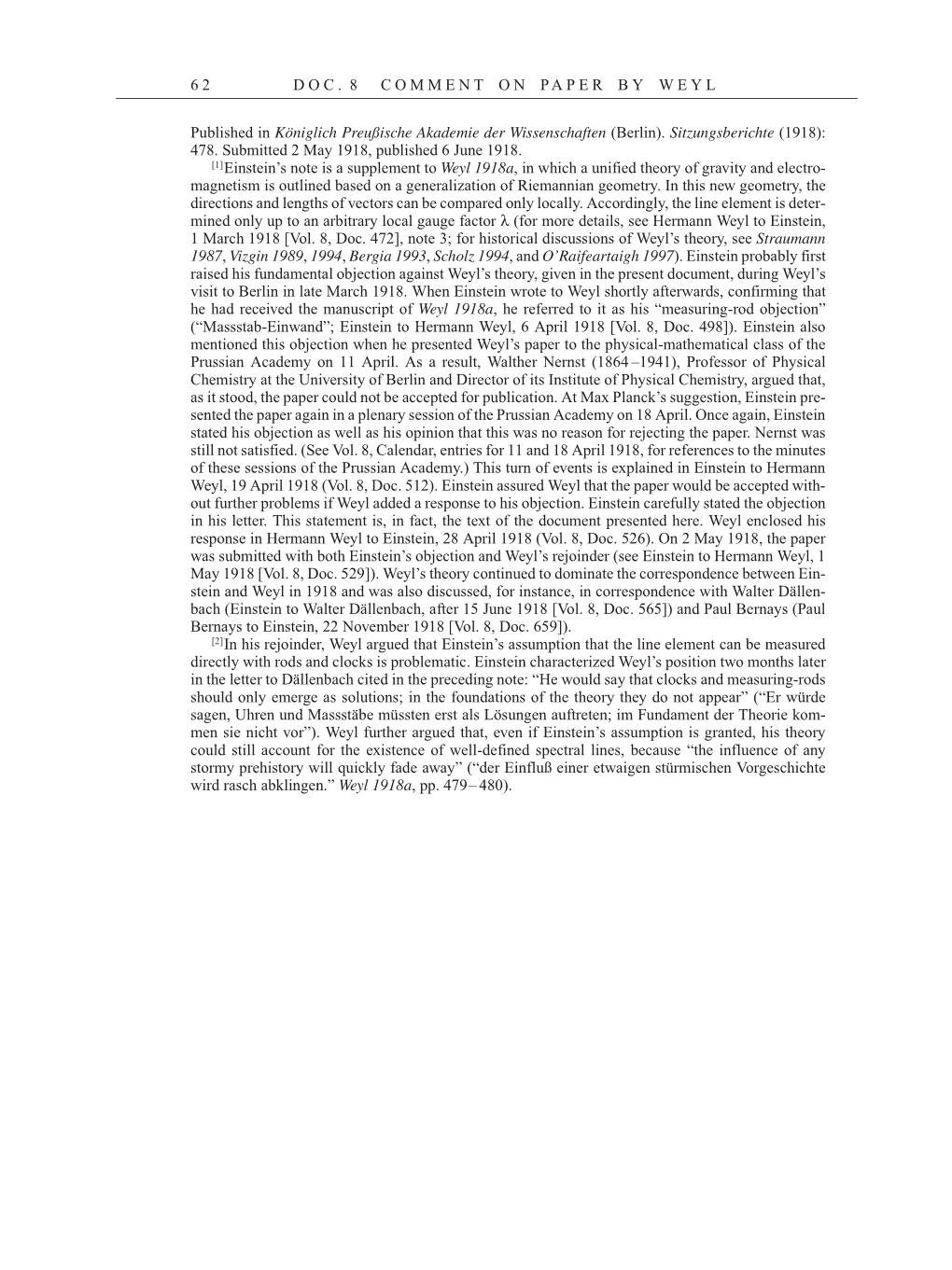6 2 D O C . 8 C O M M E N T O N PA P E R B Y W E Y L
Published in Königlich Preußische Akademie der Wissenschaften (Berlin). Sitzungsberichte (1918):
478. Submitted 2 May 1918, published 6 June 1918.
[1]Einstein’s note is a supplement to Weyl 1918a, in which a unified theory of gravity and electro-
magnetism is outlined based on a generalization of Riemannian geometry. In this new geometry, the
directions and lengths of vectors can be compared only locally. Accordingly, the line element is deter-
mined only up to an arbitrary local gauge factor λ (for more details, see Hermann Weyl to Einstein,
1 March 1918 [Vol. 8, Doc. 472], note 3; for historical discussions of Weyl’s theory, see Straumann
1987, Vizgin 1989, 1994, Bergia 1993, Scholz 1994, and OÊRaifeartaigh 1997). Einstein probably first
raised his fundamental objection against Weyl’s theory, given in the present document, during Weyl’s
visit to Berlin in late March 1918. When Einstein wrote to Weyl shortly afterwards, confirming that
he had received the manuscript of Weyl 1918a, he referred to it as his “measuring-rod objection”
(“Massstab-Einwand”; Einstein to Hermann Weyl, 6 April 1918 [Vol. 8, Doc. 498]). Einstein also
mentioned this objection when he presented Weyl’s paper to the physical-mathematical class of the
Prussian Academy on 11 April. As a result, Walther Nernst (1864 –1941), Professor of Physical
Chemistry at the University of Berlin and Director of its Institute of Physical Chemistry, argued that,
as it stood, the paper could not be accepted for publication. At Max Planck’s suggestion, Einstein pre-
sented the paper again in a plenary session of the Prussian Academy on 18 April. Once again, Einstein
stated his objection as well as his opinion that this was no reason for rejecting the paper. Nernst was
still not satisfied. (See Vol. 8, Calendar, entries for 11 and 18 April 1918, for references to the minutes
of these sessions of the Prussian Academy.) This turn of events is explained in Einstein to Hermann
Weyl, 19 April 1918 (Vol. 8, Doc. 512). Einstein assured Weyl that the paper would be accepted with-
out further problems if Weyl added a response to his objection. Einstein carefully stated the objection
in his letter. This statement is, in fact, the text of the document presented here. Weyl enclosed his
response in Hermann Weyl to Einstein, 28 April 1918 (Vol. 8, Doc. 526). On 2 May 1918, the paper
was submitted with both Einstein’s objection and Weyl’s rejoinder (see Einstein to Hermann Weyl, 1
May 1918 [Vol. 8, Doc. 529]). Weyl’s theory continued to dominate the correspondence between Ein-
stein and Weyl in 1918 and was also discussed, for instance, in correspondence with Walter Dällen-
bach (Einstein to Walter Dällenbach, after 15 June 1918 [Vol. 8, Doc. 565]) and Paul Bernays (Paul
Bernays to Einstein, 22 November 1918 [Vol. 8, Doc. 659]).
[2]In his rejoinder, Weyl argued that Einstein’s assumption that the line element can be measured
directly with rods and clocks is problematic. Einstein characterized Weyl’s position two months later
in the letter to Dällenbach cited in the preceding note: “He would say that clocks and measuring-rods
should only emerge as solutions; in the foundations of the theory they do not appear” (“Er würde
sagen, Uhren und Massstäbe müssten erst als Lösungen auftreten; im Fundament der Theorie kom-
men sie nicht vor”). Weyl further argued that, even if Einstein’s assumption is granted, his theory
could still account for the existence of well-defined spectral lines, because “the influence of any
stormy prehistory will quickly fade away” (“der Einfluß einer etwaigen stürmischen Vorgeschichte
wird rasch abklingen.” Weyl 1918a, pp. 479– 480).
